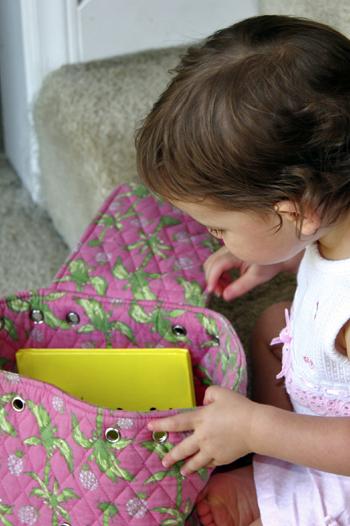Packing your bag
Duration/age

When children go to childcare, kindergarten or school they will take a bag with them. In their bag there will be things that they need every day and some things that they will only need for that day. Ask them to identify what they need every day and to locate the objects to go into the bag. Talk about what are the “only today things” and where they can find them.
Once all objects have been collected talk about the order to place things in the bag and let your child have a go at doing this on their own. When talking about order think about the size, how often it is used, what it is used for, if it is heavy or light.
Materials you will need
- Bag
Skills this activity improves
Why does this matter?
This activity develops an understanding of position and language. It helps children to understand that the size, shape and weight of objects will determine where they can be positioned. As you talk about the function of the object children will be learning to listen and to use this information to follow directions.
What does this lead to?
This activity leads to an understanding that there are different ways we measure and compare objects. Children will get an understanding of space and how to navigate and move objects within a confined space.
Language to use
- Heavy, light
- Full, empty
- First, last, next
- Together, separate
- Hot, cold
Questions to use
- What do you need to take with you today?
- How big are the things you need to take?
- What will you need first?
- Do you need to take everything today?
- Is your bag big enough to hold everything you need to take?
- Which pocket should this go into?
Useful tips
Remember to talk to your child in your home language.
Variation by age
Birth to two year olds
- Stack and build with blocks of different shapes, sizes and thicknesses.
- Sort different sized shoes into a variety of shoeboxes.
- Dig tunnels in the sandpit and work out which truck will fit in which hole.
Three to five year olds
- Build walls in the garden using bricks, stones and found objects.
- Ask your child to help put away the dishes after washing up.
- Ask your child to help stack the dishwasher.
- Go on a ‘design’ walk and look at the different patterns in paths and walls.
- Find different tubes around the house, (pipes, cardboard rolls, plumbing tubes) and see which shape balls will fit down the tube. What would happen if you used objects that were not round?
Questions to ask
- How many blocks can you stack into a shoebox?
- Does it fit?
- How big is it?
- Where does it go?
- What goes first, what goes next?
Questions to ask
- How many different shapes were used?
- What shapes can you see? What edges do they have? Are they two dimensional or three dimensional?
- Is that the right order / could it go in a different order?
- Why doesn’t it fit?
Language to use
- Top, bottom
- In, out, under
- Big, little
- Long, short
- Fat, thin
- More, less
Language to use
- Top, bottom
- Next to, underneath, alongside, against, between
- Length, width, narrow
- Long, short
- Fat, thin
- Thick, flat
- Soft, hard, squishy
- Rectangle, square, round, oval


